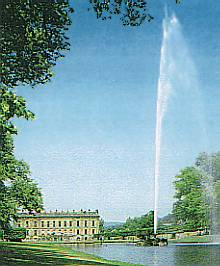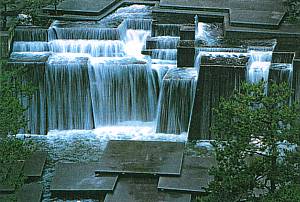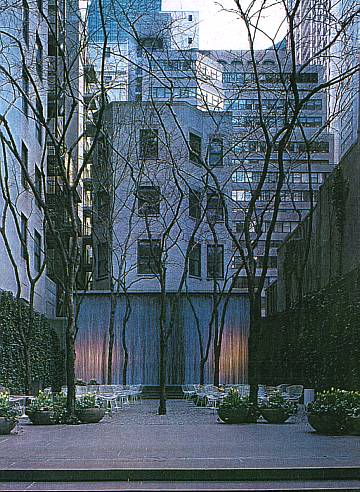|
In fact there are just three types of fountain: those which have rising jets, those with downward falls and those with a combination of the two. Rising jets are usually considered the extrovert and exhibitionist forms.  Figure 1. The Emperor Fountain at Chatsworth The geysers of Iceland and the waves of the sea striking the shore and flying upwards are natural examples of rising fountains. It is rare, however, for nature to supply a consistent rising jet unaided by man's artifice. Rising jets are most frequently used in public displays and being able to change form quickly they can be adapted for inter active forms with music or people easily. Where there is considerable water flow or advanced technique the water itself becomes the display rather than a part of the display. In Roman fountains, for example, where water is plentiful, the water, dominates the displays, but in Florence, however, on the plains, where pressurised water is a more valued commodity, it adorns and adds to sculptural fountains in a more subtle way. Now, pressure piping, powerful pumps and water projectiles, as well as the micro processor and linear flow techniques have all made possible displays in which the rising jet is used today and many modern display fountaineers rely entirely on the water for total effect. Changes in lighting can also alter their appearance radically and they may readily be seen at a distance. The combined effect has been described as "never ending fireworks." However, rising jets can be, and are, used to different effect in small gardens and also in formal gardens drawing from the Persian influence, where water is considered extremely valuable. In these instances it can be illustrated that a small spout of water is used to create a more contemplative humour and an altogether gentler use of the rising jet has evolved. The cascade or downward fall fountains have a far greater place in nature. In nature they are all rivers and streams, all waterfalls and all rising springs. Man has contained them, rerouted them, embellished them, miniaturized them and finally emulated them using artificial pumping systems, (figure 2.) and now that we are starting to understand scientifically the good effect that all fountains, and particularly cascades, have on water, we are continuing to use them to purify and revitalize our supplies.  Figure 2. Ira's Fountain. Portland. Oregan. U.S.A. The earliest surviving carved water basin, dating from around 3000 BC., was discovered at the site of Tello, one of the cities of Mesopotamia. At Mari, another of the most important cities, a stone fountain figure dating from around 2000 BC was discovered. The figure can be considered a prototype for the kind of fountains made in gardens for thousands of years thereafter: a female goddess holding a base into which water is piped to cascade forth, symbolizing the source of all life, the ultimate creative force of the garden. In the garden a cascade, is usually integrated into a natural arrangement, and often used to develop the introverted, timeless and private aspect of gardens. Palaces and houses of the powerful have frequently been located to maximize the relationship with cascades. This is particularly so as cascades are very often found at places of great natural beauty and good "Fung Shui" as the Chinese would say, to describe a location with excellent air, light and water. The cascade is also a symbol of power and wild nature, for example, at Niagara Falls in New York State in America where people, especially the newly wed, assemble to be awed by the might of nature. In the writers youth in Hong Kong the annual visit to the overflowing reservoirs not only heralded the end of the annual water restrictions but made a powerful effect with the roar of white water flying through the narrow overflow channels. In post renaissance Europe Le Notre and his pupils and successors developed the ideas of the Renaissance garden cascade, extending and formalizing it. Cascades of great length evolved all over Europe. These we shall illustrate with examples, including Chatsworth in Derbyshire. America, which often utilizes new technology more swiftly and effectively than the old world, offers some very exciting examples of cascades utilizing closed water systems and electric pumps. Examples to illustrate this include: Paley Park in New York (Figure 3), with its wall of water and Ira's fountain (Figure 2.) in Portland. Oregon.  Figure 3. Paley Park. New York. |

http://www.gardening-uk.com/waterlands/
email: b.hirst@mac.com